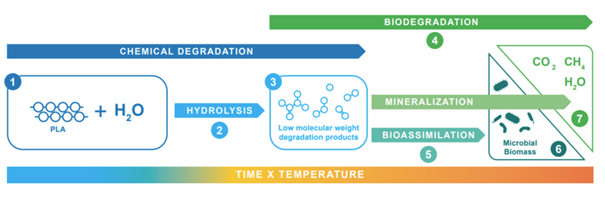
Environmental Footprint
LOW CARBON FOOTPRINT
PLA has a lower carbon footprint compared to traditional fossil-based plastics. PLA is derived from renewable resources and retains the carbon originally absorbed from the atmosphere by the biomass used in its production.
Environmental Footprint
PLA does not release persistent micro- and nanoplastics into the environment
Primary microplastics are small plastic particles that are directly released into nature during the manufacturing, use, or maintenance of plastic objects. Examples of primary microplastics include the erosion of tires while driving, microbeads in cosmetics, and the abrasion of synthetic textiles during washing.
Secondary microplastics are smaller plastic fragments that originate from plastic items that degrade once exposed to the environment. This includes mismanaged plastic waste and fishing nets.
Environmental Footprint
The finding that PLA does not release persistent micro- and nanoplastics into the environment comes from a comprehensive meta-study commissioned by Holland Bioplastics and conducted by HYDRA Marine Sciences, which reviewed a range of peer-reviewed studies. As concerns over fossil-based plastic pollution and its long-term ecological impact continue to rise, PLA, a biobased, compostable and recyclable alternative, emerges as a promising solution for industries seeking to adopt greener practices.
Environmental Footprint
PLA Degradation Compared to other materials in the environment
All materials decompose in the environment through natural fragmentation processes (abiotic factors) and biodegradation (biotic factors). Although the degradation process is the same across soil, freshwater, and marine environments, the rate at which it occurs can vary depending on the environmental conditions.
PLA, a biodegradable plastic, degrades via natural processes, similar to natural products like leaves or wood. PLA’s molecular structure makes it susceptible to chemical attack by water (hydrolysis), which means it will fully hydrolyse and biodegrade, leaving no persistent plastic particles that could accumulate in the environment.
In contrast, non-biodegradable plastics like PE, PP, or PS, which do not possess low-energy degradation pathways such as hydrolysis in natural environments, can release toxic molecules in the environment. The processes of hydrolysis and biodegradation for PLA contrast with persistent microplastics originating from non-biodegradable plastics. While PLA degradation releases lactic acid, a naturally occurring molecule produced and used as a source of carbon for plenty of micro-organisms, non-biodegradable plastics could cause long-term environmental damage. Therefore, materials like PLA only have a temporary presence in the environment.

Process of PLA Biodegradation
In the presence of water (1), PLA undergoes hydrolysis (2) as a pure chemical process of polymer degradation, during which low molecular weight intermediates (3) such as oligomers and lactic acid monomers are produced. These become soluble and can be biodegraded (4). Microbes take up these oligomers and monomers as food (5) and use them to build up biomass (6) and as energy for metabolism. Ultimately, this leads to the mineralization (7) of the original polymer carbon into carbon dioxide, methane, and water.
Source: Holland Bioplastics, Hydra Marine Sciences. (2024). PLA does not create persistent microplastics in the environment
Link to the Technical Summary Report
